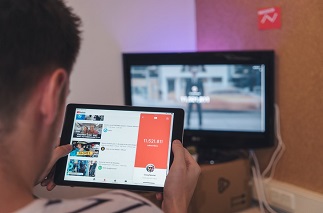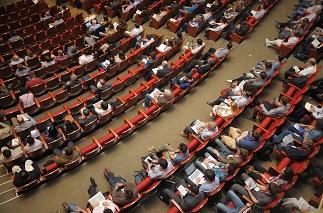Posts

Journalism on Forced Migration in Latin America: Recommendations from Experts and International Journalism Guides from a Qualitative Study
Wars, insurgent groups, dictatorships, and economic crises are the main reasons for forced migration. Displaced persons, asylum seekers, and refugees often face public stigmatization, as they are treated by the media as a social problem and, in many cases, seen as economic and social threats. This article presents the results of in-depth interviews with expert journalists and researchers from different Latin American countries on the phenomenon of forced migration and its journalistic coverage. Their recommendations are complemented by Qualitative Document Analysis (QDA) of international guides on migration journalism. The findings highlight the need for training and awareness-raising in critical skills and social analysis for journalists to understand the complexity of human mobility and approach it from a human rights perspective, as well as to project the positive contributions of migrants to the host society. Findings suggest the need to avoid disseminating and magnifying hate speech, which may be used to justify discrimination and violence against migrants. This highlights the fact that migration issues must be dealt with under slow journalism schemes, with an emphasis on research, thus avoiding falling into xenophobic discourse due to the very immediacy that the digital ecosystem demands.

‘Millennials and centennials’ perspective on Streaming narratives in Spain and Mexico: Spiral of silence, bandwagon effect, and third person effect
Viewers are increasingly used to the link between entertainment and technology in the current media ecosystem. The success of consuming streaming platforms when watching movies and series shows how the audience is more involved in new forms of viewing, at any time, at any moment, and with any content. This research aimed to examine the perception of millennial and centennial audiences in Spain and Mexico, the two Spanish-speaking countries with the highest streaming consumption, about audiovisual content producers for entertainment. Three theories on public perception (spiral of silence, bandwagon effect, and third-person effect) were used as the basis of the research questions to unravel the extent to which younger audiences in these countries consider that production companies are, or are not, ethical in the representation of what may be labeled as "sensitive topics". The results show that centennials are more confident in their critical perceptions of controversial issues in movies and series, while, on the other hand, millennials approach their perceptions with more cautiousness and confusion.

Girl YouTubers: Interaction, creation, and emotions during COVID-19 confinement
The COVID-19 pandemic forced absolute confinement in Spain from March 15 to July 21, 2020. On the other side of the screen, YouTubers girls and boys, creators of specific content for their peers, took the opportunity to increase their productions. This research examines 73 creations made during the confinement period by six Spanish girls YouTubers categorized as influencers by the number of reproductions and followers of their channel sthrough content analysis to evaluate the interactions, the content generated, and subjective aspects of projection of the emotional state of these minors. The results show increased interactors, positioning the female sector as the most prevalent gender. The contents have been related to the COVID-19 theme, while, in the emotional aspect, the influencers were not affected by the great sadness that hit Spain with the death of thousands of people.

The Process of The Transfer of Hate Speech to Demonization and Social Polarization
We are living through a time of major political changes due to the rise of populist leaders and the resurgence of extreme ideological movements. The emergence of this phenomenon is due, to a large extent, to the ease with which these political actors can disseminate and spread their messages without any limits through social networks, leaving aside the former “fourth power” of the media as filterers and reinterpreters of information. Generally, the formula used by these leaders and movements is usually based on symbolic social division and polarization through hate speeches that allow demonizing their adversaries while antagonizing the issuers: a discursive “us” against “them” based on verbal violence to dehumanize an “exogroup.” We want to discuss the importance of understanding the process of communicational transfer—which begins with hate speech and evolves into demonization and social polarization—as a strategic basis for creating an ideal scenario for the growth and strengthening of populist discourse, which is reductionist and simplifying in nature.

How to Botox’ on YouTube: Influence and Beauty Procedures in the Era of User-Generated Content
The current media environment is complex and has important effects on all aspects of life, including beauty and health. In this sense, YouTube has become one of the main contexts for the dissemination of tutorials and content related to medical procedures such as the application of Botox. Thus, the present study constitutes the first exploratory analysis of YouTube videos in Spanish related to this procedure. A preliminary analysis of 221 YouTube videos yielded a final sample of the 50 most viewed videos within this genre. The analysis was carried out through a quantitative content analysis assessing the popularity of the videos, contact and emotive strategies by the creator, the credibility conveyed, and the characteristics of information about the procedure itself. Results suggest that these influencers align with mainstream Internet celebrity culture in practices that aim at increasing their following and views, as well as calls for subscriptions and visits to other platforms and profiles. Moreover, they include different strategies to establish their credibility but emphasize personal experience. The positive portrayal of the procedure, including positive emotions and content that highlights the benefits, is interesting and supports the commercial nature of much of the content.

Coworking spaces and virtual learning communities in social networks: Case Study of #ElClaustrodeIG on Instagram
Social networks are consolidated as spaces for the exchange of valuable content. It is not surprising to find spaces for the exchange of good teaching practices in virtual learning communities, so the objective of this study is to analyze, through the case study of #ElClaustrodeIG on Instagram, the educational content focused on teaching that is shared for the Ibero-American community in Spanish, as well as the analysis of the users who share their experiences and good practices in this social network. In order to do this, content analysis is first carried out, through an analysis sheet to 300 posts and a questionnaire is applied to 130 users of this hashtag on Instagram in order to analyze their patterns of use, their interests and motivations, their training in ICT and social networks, as well as the impact that the use of this social network has on their professional development and the gratification they expect. The results show that most of the publications are about good practices for primary and preschool education while most of the users think that Instagram is an ideal space for non-formal learning, applying in the classrooms many of the good practices shared in this coworking space.

The Demonization of Islam through Social Media: A Case Study of #Stopislam in Instagram
This article studies the process of demonization, its consequences, and how social media contribute to the formalization of its axiology. The demonization of societies aims to create social subjects that fit into the idea of the “other” by exposing them to compulsory invisibility. This research’s main objective was to examine how demonization is used as a weapon of oppression to devalue specific individuals through the hashtag #StopIslam and Instagram’s role in this process. The methodology used for this purpose has consisted of an empirical and quantitative analysis of the most recent (1 January 2020–31 July 2020) posts on Instagram with #StopIslam, analyzing the images and the content. The study has determined how, through social media manipulation, erroneous ideas are transmitted that prevent the Islamic collective’s integration, especially in European countries. The conclusions will reflect hate speech and how the Islamic world’s demonization results in the Muslim community’s stigmatization, racism, and Islamophobia. Although there are different articles related to demonization and hate speech, there are not many scientific resources that explain these variables on Instagram and how it affects the inclusion of the Muslim community in Europe, significantly when the time spent on the Internet is growing.

Kid influencers in Spain: understanding the themes they address and preteens’ engagement with their YouTube channels
This research analyses the contents of the videos of the ten Spanish children's YouTube channels with the highest number of followers and video plays to identify correlations between the thematic axes of the videos and the increase in digital engagement data. Little is known about the topics that the most popular Spanish-language YouTube influencers share with preteens and young adults' audience. In response, this exploratory study will use content analysis to examine this gap and contrast the themes that its videos reflect against others. For this purpose, interpretive-based content analysis is carried out based on an analysis sheet validated by expert judgment. Among the main results, it is shown that most of the children who are the lead character of the channel are currently between 10 and 12 years old, having created the channels an average of five years ago, which shows how early many YouTubers are starting in this industry. There are also differences in the thematic axes of the channels' videos according to the gender of the children's influencers, with a higher representation of male YouTubers devoted to gameplays, while their female peers have a more significant presence in videos in the lifestyle category. It is concluded that there is a need to supervise the contents accessed by children on this platform since it can deepen not only gender gaps but also become a wrong reference of role models.

Learning Leaders: Teachers or Youtubers? Participatory Culture and STEM Competencies in Italian Secondary School Students
Youth is increasingly learning in non-conventional contexts, such as social networks or video platforms, courses, and tutorials. This research aims to diagnose the role of participatory culture, digital resources, social networks, and, specifically, YouTube, in learning processes and the acquisition of Science, Technology, Engineering, and Mathematics (STEM) skills, specifically in mathematics, also analyzing the role of youtubers and, in contrast, teachers, both learning leaders in the formation of these skills. In order to accomplish this, mixed methods (quantitative and qualitative) were used, based on a survey applied to 4845 Italian adolescents, as well as a content analysis of the videos and YouTube channel of the Italian educational influencer Elia Bombardelli, one of the most followed and best rated in this country. Also, an in-depth interview has been applied to 12 Italian secondary school teachers. Among the main findings, it is highlighted that all adolescents value YouTube videos as a key resource to improve their school performance, rating youtubers better than teachers. However, it is remarkable that in the processes of learning and acquisition of STEM competencies, they prefer to interact with teachers rather than with youtubers.

The notion of educommunication in intergovernamental organizations
This research analyzes the notion that the main international organizations of multilateral character have on the concept of educommunication (media literacy), by means of the correlational extract and analysis of the content of interpretative base of 2.648 information units from 12 organizations, both regional and transcontinental, including the United Nations, the Organization for Economic Cooperation and Development, the Arab League, the International Organization of la Francophonie, the Community of Portuguese-speaking Countries and the Organization of Ibero-American States, African Union, European Union, League of Arab States, Commonwealth of Independent States, Organization of American States, Commonwealth of Latin American and Caribbean States, Union of South American Nations, Association of Southeast Asian Nations, Cooperation Council for the Arab States of the Gulf and Pacific Islands Forum. Regarding the main results, it is evident that 83% of the organizations analyzed, except in the Community of Portuguese Language Countries and in the African Union, the convergence of the educational and communicative context is specifically presented under the terminology “media education”, which influences the formulation of domestic policies through the proposal of incentives and restrictions that affect decision making at the governmental level, alluding to the continuous change and the dynamic construction of identity.
